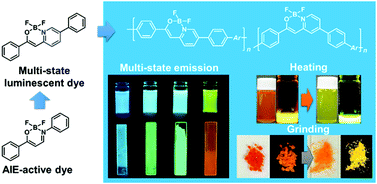Stimuli-responsive luminochromic polymers consisting of multi-state emissive fused boron ketoiminate†
Abstract
We developed linear and zigzag-type polymers consisting of fused-boron ketoiminates having not only efficient emission in multiple states, such as in solution and film, but also stimuli-responsive luminochromic properties. In the previous research, we found that highly efficient multi-state luminescence can be obtained through modification of the aggregation-induced emission-active boron complexes by introducing a ring fusion. Based on this result, we designed alternating copolymers containing these fused-boron ketoiminates as a monomer unit. In particular, by changing the connection point at the boron complex, the shape of the polymer chain was varied to modulate the degree of molecular interactions. The obtained polymers exhibited intense emission in both solution and film states. Interestingly, we found that one of the linear polymers presented thermochromic luminescence in solution. From the series of mechanistic analyses, it was proposed that assembly should play an important role in their stimuli-responsive luminescence color changes. Moreover, a mechanochromic luminescence property was also observed from the zigzag-type polymer in the solid state. The luminochromic behavior could originate from changes in the morphology of the conjugated polymers after grinding.



 Please wait while we load your content...
Please wait while we load your content...